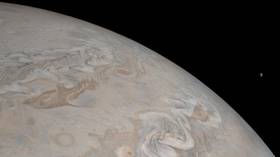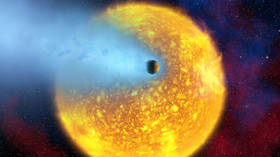Planet smashes record for most moons in solar system

Jupiter has officially become the planet with the most moons in the solar system, now counted at 92, thanks to the discovery of 12 more natural satellites, astronomers have said.
The previous record-holder, Saturn, has dropped to second spot, being orbited by 83 confirmed moons.
Jupiter’s newly found companions were recently added to a list kept by the International Astronomical Union’s Minor Planet Center, Scott Sheppard of the Washington-based Carnegie Institution, who took part in tracking the moons down, told AP on Friday.
The moons were spotted with telescopes in Hawaii and Chile in 2021 and 2022, but the scientists needed to follow their entire orbits in order to make the discovery official.
Those new satellites range from 1km to 3km (0.6 miles to 2 miles) in diameter, Sheppard said. Only half of them will be named however, the rest being below the minimum diameter of 1.5km for naming, he added.
Three moons traveling in a prograde direction – the same as the planet's rotation – were especially tough to detect, the scientist said in an earlier interview with the Sky and Telescope website. “The reason is that they are closer to Jupiter and the scattered light from the planet is tremendous,” he explained.
The large number of small satellites around both Jupiter and Saturn are believed to be fragments of larger moons that crashed into each other or collided with comets, according to Sheppard.
“I hope we can image one of these outer moons close-up in the near future to better determine their origins,” he told AP.
The European Space Agency is sending a spacecraft to study Jupiter and one its biggest moons in April, while NASA’s mission to the planet's Europa satellite, which could host an ocean under its ice crust, is planned for 2024.
Jupiter and Saturn vastly outnumber the rest of the planets in our system when it comes to the number of natural satellites. Uranus is orbited by 27 confirmed moons, Neptune by 14, Mars two and Earth one. Venus and Mercury have no moons.













